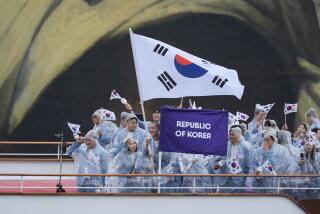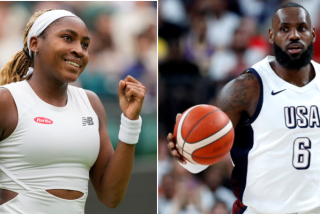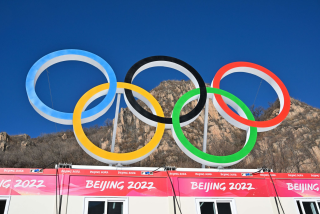Koreas to Show Unified Front
- Share via
SYDNEY, Australia — In what promises to be a historic illustration of the symbolic power of sports to bring people together, the two Koreas will march as one in the opening ceremony of the Sydney Summer Games, IOC President Juan Antonio Samaranch confirmed Sunday night.
Athletes from North and South Korea will walk together Friday night into Stadium Australia, wearing the same uniform and walking behind the Korean “unification flag,” Samaranch said. When the Games begin, they will compete for their separate nations, he said.
To thunderous applause in a speech at Sydney’s famed Opera House that opened the IOC’s 111th session, Samaranch declared that the march would symbolize “friendship, solidarity and peace.”
Afterward, North Korea’s IOC member, Chang Ung, was asked by reporters to explain why his long-reclusive nation had agreed to the joint march. Chang speaks English haltingly. But in answering, he not only expressed a people’s hopes for reunification on a peninsula divided for 50 years, he provided a potent reminder of why the Olympic movement relentlessly persists in promoting sports as a path to world peace.
“We are the same blood,” Chang said.
The march will mark the latest step in a fledgling rapprochement established at a historic summit in June between South Korean President Kim Dae Jung and North Korea’s leader, Kim Il Jong.
In July, in the first concrete sign of progress after the summit, the two countries announced they would reconnect a railroad line that has been severed since the Korean War.
Last month, 200 Koreans separated from their families for half a century--100 from the North, 100 from the South--were reunited with them, albeit for only three days.
Earlier this month, as a goodwill gesture, South Korea repatriated 63 former Communist spies and guerrillas--some on stretchers and in wheelchairs--who had spent decades in South Korean prisons.
Technically, the two Koreas remain at war, divided along the 38th parallel since 1953.
During the Sydney Games, the Koreas will compete as separate countries, with their own uniforms, flags and anthems.
But in Friday’s ceremony, Samaranch said, they will enter Stadium Australia as a joint delegation to be called “Korea,” behind the “unification” flag, which will be carried jointly by two athletes, one from the North, one from the South. The flag features a depiction of the peninsula, officials explained afterward.
The “Korea” delegation in the march will number 180, Samaranch said. North Korea’s team, including coaches and administrators, totals about 70, and it remains unclear how parity in numbers can--and will--be achieved in the march. South Korea is sending about 280 athletes and 120 officials to Sydney.
There are other details that have yet to be finalized, including the marching uniform, but South Korea’s IOC member, Kim Un Yong, said it’s likely the delegation will be dressed in blue and gray.
“The important thing is not the details,” Kim said. “The important thing is the two teams marching as one in the eyes of the world--moving as Korea, as one delegation, as a symbol of unification, friendship and peace.”
Samaranch had disclosed earlier Sunday in an interview with The Times--reported in Sunday’s late editions--that the unified march was on. It springs from an initiative he launched just before the Korean summit.
In a May 25 letter sent separately to the South and North, Samaranch advocated a joint march. He proposed that all Korean athletes march behind the Olympic flag, followed by the flags of their nations.
South Korean officials promptly said yes.
North Korea did not immediately reply.
In mid-June, meeting in Pyongyang, capital of the Communist North, Kim Dae Jong and Kim Il Jong signed a declaration that said the two sides wanted to “build up trust between each other” by developing a “national economy” and by cooperating in such fields as “society, culture, sports, health and environment.”
A photo taken at the end of the summit shows the influence of Kim Un Yong, an IOC member and a senior advisor to Kim Dae Jung--even as it confirms the import of sports in Korean politics.
In the front row of the photo, joining hands while singing “Our Wish is Unification,” stand Kim Dae Jung and Kim Il Jong; Kim Un Yong stands immediately behind the North Korean leader.
In late July, Pak Myong Chol, the head of the North Korean national Olympic committee, sent Samaranch a letter saying he didn’t see the need for two national flags in a joint march, given that the ultimate goal is unification. Responding to Pak’s July letter, the IOC Executive Board--in a letter signed by Samaranch--proposed that the two Koreas march behind the Olympic flag only.
Samaranch--who as president of the IOC since 1980 consistently has sought to advance the cause of peace, no matter how utopian the notion--long has taken a special interest in the Korean peninsula.
In 1988, he coaxed more than 160 nations to the Seoul Games--thereby ending the era of the Olympic boycott, which marked the 1984 Games in Los Angeles and the 1980 Games in Moscow. In recent years, the IOC has on a number of occasions donated large shipments of rice to North Korea.
Meantime, days from the 2000 Games’ opening, the IOC still was waiting for an answer from the North.
Upon the arrival last week in Sydney of Samaranch and the other individuals of the 11-member IOC Executive Board, the status of the joint march appeared very much in doubt. Yet Samaranch recounted Sunday night: “We’ve had some letters, we’ve had some meetings, maybe two meetings every day for the last three or four days.”
The stumbling block was the numbers issue. The North Koreans did not want to be seen to be overwhelmed by a much-larger South Korean delegation.
Even so, Samaranch added: “Mr. Chang and Mr. Kim wanted to reach this agreement.”
Final approval for a joint march came Sunday afternoon from Pyongyang.
North Korea’s Chang, asked after Samaranch’s speech whether the march would help lead to peace on the peninsula, answered: “Of course.”
South Korea’s Kim Un Yong said, “I think the whole world likes this.”
Anita DeFrantz of Los Angeles, an IOC vice president, said on her way out of the Opera House that the opening ceremony ought to be something truly special. “It might,” she said, “bring a lot of people to tears on the 15th of September.”
*
FIRST, SHE’S A RUNNER
Marla Runyan wants to eclipse title as the first blind U.S. Olympian. Page 14
More to Read
Go beyond the scoreboard
Get the latest on L.A.'s teams in the daily Sports Report newsletter.
You may occasionally receive promotional content from the Los Angeles Times.






